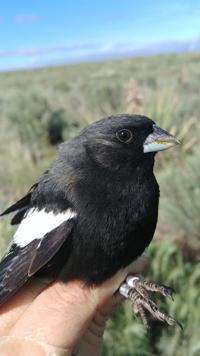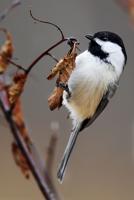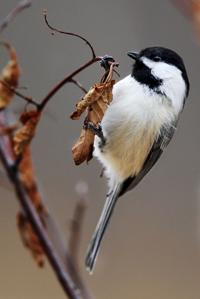I don’t mean to cause a panic, but Colorado’s sweet little state bird, the black and white lark bunting, is on the decline.
And it’s mostly because we’re destroying their beloved short grass prairie habitat. Their populations have declined about 2% a year since the late 1960s, said Clark Jones, vice president of the Colorado Springs chapter of the Aiken Audubon Society and a wildlife biologist for the U.S. Fish and Wildlife Service. Those numbers are care of the North American Breeding Bird Survey, a nationwide survey that started tracking such statistics in 1966.
The buntings’ grassland habitat is being converted to agriculture, said Jones, and expensive overgrazing by cattle also can cause a problem.
“They do seem to tolerate some disturbance fairly well,” said Jones, “but there’s only so much they can take.”
If you live on the east side of town, you might think this is pure poppycock, as you’ve likely seen a large number of lark buntings this year. You probably won’t find them in downtown Colorado Springs. But as soon as you get out past the Colorado Springs Airport, you’re sure to pick them out. Indeed, it’s been a good year for the bird, with our cold, wet spring, said Ted Floyd, editor of Birding magazine.
“Numbers do rise and fall,” said Floyd. “But in general, the long-term decline is due to habitat type that was restricted to begin with, and now more than ever, in light of the warming and drying of the climate.”
Strangely enough, the lark buntings are neither lark nor bunting. They’re a sparrow. “It’s a bit showy. As sparrows go, it’s large and spectacularly patterned,” said Floyd.
There’s also an interesting story that accompanies how they became our state bird. At the height of the Great Depression, a contest was held to decide what winged creature would represent us in the union. A little girl in Denver suggested the lark bunting because it was black and white and could save money when pictures of it were printed, because they wouldn’t have to worry about making them in color. The Legislature agreed and approved it.
As with most things, a faction of folks think the bunting is a less than optimal choice. Floyd has no qualms with the bird — “Buntings are cool, and it’s magical to be on the prairie and see the prairie come alive with them.” But he’d like the king fowl to be one that more people could see on the regular.
“I joke that you could spend your whole life in Denver or Colorado Springs and never see the state bird,” he said. “If you live in Grand Junction, the bird doesn’t occur there.”
He’d vote for the black-billed magpie or the Western tanager, the tropical-looking bird that enjoyed quite a moment in the spotlight this spring with its numerous sightings.
So how can we help protect our fair state bird from disappearing? Clearly, we need to promote activities that preserve and protect grasslands, especially in the areas east of Interstate 25. We also can support organizations that promote habitat restoration and conservation.
“More generally, though, there’s the bigger question of the warming and drying of the climate and reducing greenhouse gas emission,” said Floyd. “Favoring practices and policies that protect their habitat is the way to go.”
Contact the writer: 636-0270











 Your Privacy Choices
Your Privacy Choices